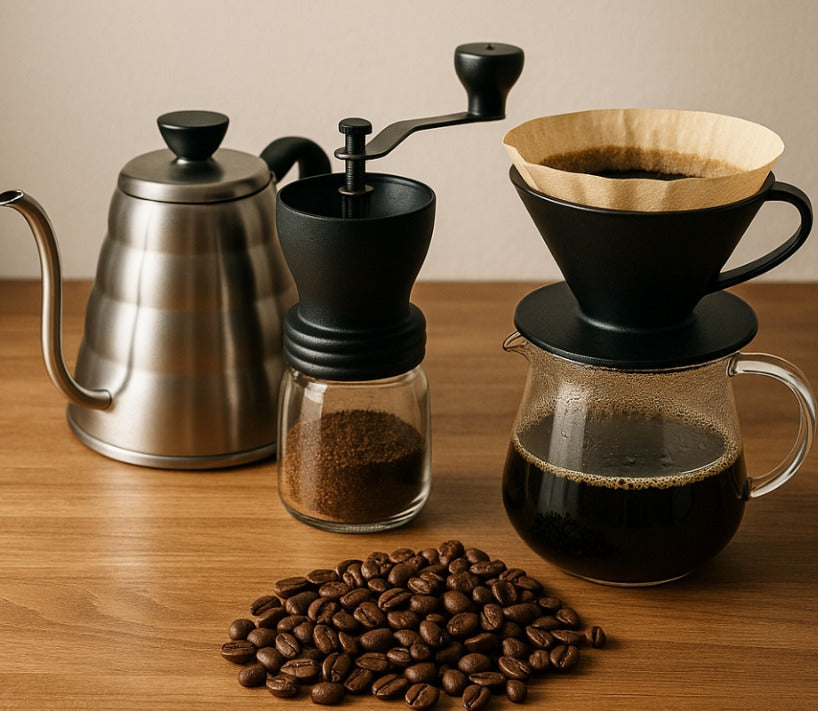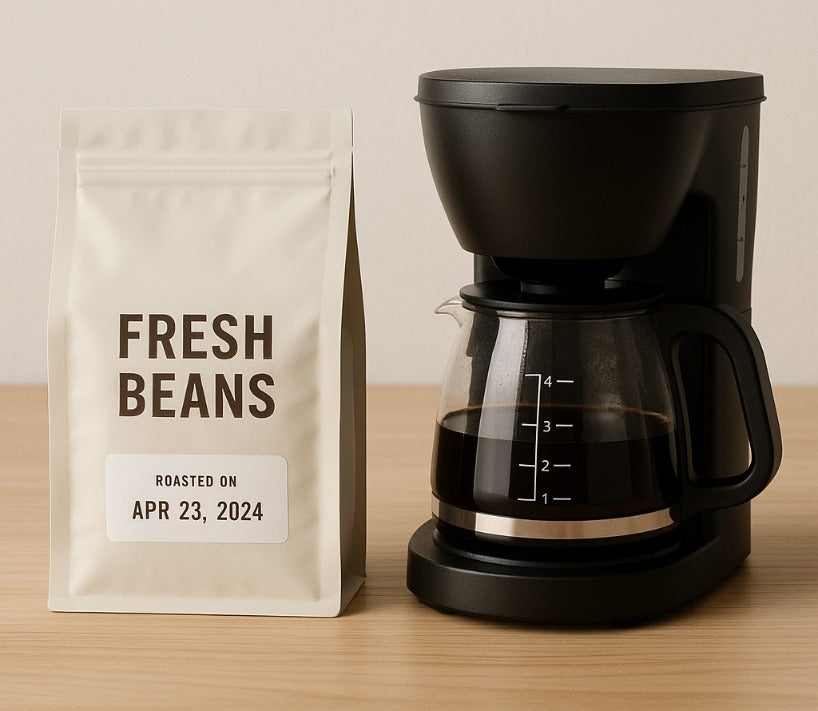Why Electric Drum & Fluid-Bed Roasters Make the Cleanest, Tastiest Coffee on Planet Earth
May 28, 2025 4 min read
Bean to Greatness: Why Electric Drum & Fluid-Bed Roasters Make the Cleanest, Tastiest Coffee on Planet Earth
The Smell of Science (and How I Accidentally Became That Person Who Sniffs Air)
I used to think all roasting was the same: toss green beans into a spinning metal barrel, crank the fire, wait until the kitchen smells like a camp-out, and—voilà—morning hero brewed. Then I toured two wildly different setups: one gas-guzzling drum that looked like a vintage locomotive, and one sleek electric rig that reminded me of a NASA wind tunnel. I left the gas roastery smelling like I’d wrestled a bonfire; I left the electric spot smelling… well, normal.
Cue the light-bulb moment. If I can tell the difference just by breathing, imagine what those volatile aromatics (the ones that make the best tasting whole bean coffee sing) are doing inside the bean. Down the rabbit hole I dove, and up bubbled today’s topic: electric drum roasting and fluid-bed electric roasting—two modern approaches that consistently out-clean and out-flavor traditional gas roasting. Ready to geek out with me? Let’s roast.
Breaking Down the Heat Sources, One Crack at a Time
1. The Combustion Conundrum
Gas roasters rely on open flame or indirect burners. Flames mean combustion; combustion means hydrocarbons, nitrogen oxides, and the occasional sulfur hitchhiking onto your beans. Even with afterburners, trace residues can muddy delicate notes. Electric heat? Zero combustion, zero exhaust particles clinging to your future latte—exactly what you want when chasing the best craft coffee at home or browsing “specialty coffee near me.”
2. Electric Drum Roasting—Old-School Charm, New-School Control
Picture your favorite cast-iron skillet, but powered by laser-precise electric coils instead of flame. Beans tumble in a drum, absorbing mostly conductive heat plus a bit of convection.
-
Microsecond Adjustments – Electric coils respond fast; if first crack races, you can cool things in seconds.
-
Even Surface Temperatures – No flame hotspots; fewer scorched rebels contributing bitterness.
-
Less Smoke – Coils heat metal, not exhaust-filled air, keeping flavors sweet and clear—great for those hunting the best espresso beans.
3. Fluid-Bed Electric Roasting—Coffee Meets Jet Stream
If electric drums are high-tech skillets, fluid-beds are coffee-bean Jacuzzis run by tornadoes. A powerful blower suspends beans in super-heated air, transferring heat almost 100 % convectively.
-
No Contact Scorching – Beans never touch hot metal, preserving vibrant acids prized in light roasts.
-
Ultra-Uniformity – Every bean sees identical airflow—no hiding in cooler corners.
-
Chaff Ejection – The breeze blows silver skin away mid-roast, nixing smoky flavors.
-
Rapid Cooling – Most batches chill in under 30 s, locking in aromatics.
4. Data Is Delicious—Profiling Power
Both electric systems pair with real-time software. Nail that perfect curve once and you can replay it at will—catnip for any roaster aiming to land on “top coffee delivered” lists.
5. Greener Beans, Greener Planet
No gas flame = big CO₂ savings. If the roastery’s electricity comes from renewables, your cup’s carbon shadow shrinks even more—great news for eco-minded folks who like to order coffee online with a clear conscience.
Electric Drum vs. Fluid-Bed: Quick-Fire Showdown
| Feature | Electric Drum | Fluid-Bed Electric |
|---|---|---|
| Heat Transfer | Conductive + some convective | Pure convective |
| Flavor Signature | Syrupy body, caramel sweetness | Bright clarity, fruit-forward |
| Batch Size | 1 kg hobby to 60 kg commercial | 50 g sample to ~30 kg |
| Energy Response | Fast, even | Super-fast, minimal thermal mass |
| Noise Level | Drum clunk | Hair-dryer on turbo |
| Cup Cleanliness | Cleaner than gas | Cleanest possible |
Short answer: crave mocha-rich comfort? Electric drum rocks. Dream of strawberry-candy Ethiopians? Fluid-bed may steal your heart. Either way, both beat gas in cleanliness.
6. Why Gas Roasters Still Dominate (and Where They Struggle)
Heritage, big batch sizes, and lower energy rates keep gas popular. But gas flames react slowly, need more maintenance, face stricter emissions regs, and can impart unwanted smokiness—especially problematic for high-scoring micro-lots headed for “best specialty coffee online” fame.
7. Myth-Bust: “Electric Can’t Build Body”
Body comes from Maillard reactions, not from fossil fuel. Electric drums can develop syrupy shots; fluid-beds can thicken mouths by extending post-crack development. I’ve pulled brownie-batter espresso from a 100 % electric rig—my taste buds can testify.
8. Practical Takeaways for Curious Brewers
-
Ask About Roast Method – When browsing the best coffee online, look beyond origin and tasting notes.
-
Match Method to Palate – Chocolate lovers → electric drum. Fruit fanatics → fluid-bed.
-
Store Smart – Even the cleanest roast fades; airtight and away from light is still the rule.
-
Gift with Purpose – Matching roast style to a friend’s taste beats any novelty mug, making electric-roasted beans top-tier presents for coffee lovers.
Your Next Sip, Upgraded
You’re now an honorary roast engineer. You know electric drum and fluid-bed systems dodge combustion, harness precision, and reveal flavors gas often smothers. Next time you hunt for the best small batch coffee or decide where you’ll buy specialty coffee online, you’ll scan for “electric-roasted” like a seasoned pro.
Choose bags that preserve terroir, respect our planet, and make your cup sing—whether for your daily brew, a gift for coffee lover buddy, or bragging rights at brunch. In the electric-versus-gas showdown, the real winner is your palate. Cheers to cleaner, tastier coffee—may your mornings be bright and your burr grinder forever sharp.
Also in Best Coffee To Buy Online Education

Brewing The Best Coffee at Home: Stop Waiting in Line
November 03, 2025 4 min read
Learn Brewing The Best Coffee at Home with a quick Proof → Promise → Plan system: choose fresh, roast-dated beans, use a simple 1:16 recipe at 200°F, and lock a 4–6 minute routine that beats the drive-thru on taste, time, and cost.

Best Tasting Coffee At Home: Stop Buying “Deals,” Start Buying Value
November 02, 2025 4 min read
Want the Best Tasting Coffee At Home? Skip old ‘deal’ beans. Use fresh, high-scoring, air-roasted coffee and a simple 1:16 plan. This guide shows proof, a clear promise, and a step-by-step plan to order smart, brew better, and enjoy sweeter, cleaner cups—daily.

Best Coffee To Make At Home: Fresh Beans, Simple Plan
October 31, 2025 4 min read
Learn the Best Coffee To Make At Home with a tiny, repeatable system: pick fresh, high-scoring, roast-to-order beans; brew at a simple 1:16 ratio; fix cups with one change at a time. Includes a comparison table, freshness rules, and beginner-friendly FAQs.
